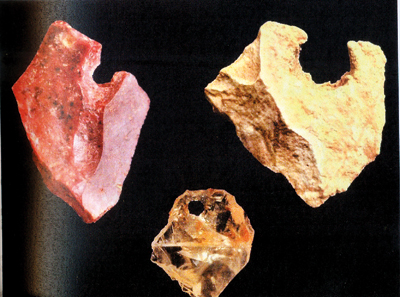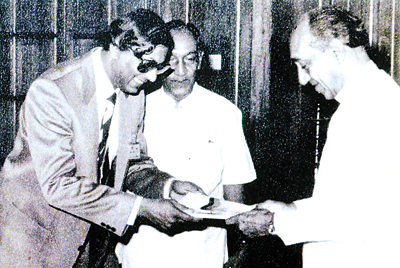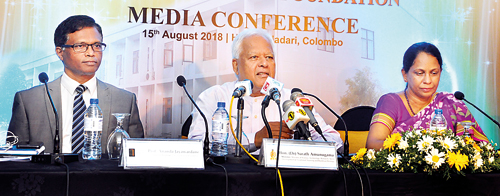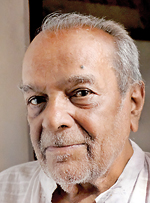Preserving our past and taking us to the future

Three symbolic objects, probably prehistoric pendants of quartz and chert stones unearthed from the excavations at Alugalge
Whether it is preserving the valuable traditional knowledge of Sri Lanka’s farmers through documentation; a forecast on crop-mapping at the touch of a keyboard; a system of dots to help the blind become computer savvy; or taking a close look at the pre-historic inhabitants of this land, there is a thick golden thread running through them all.
The thread which has woven a rich and unique tapestry throughout the country and been able to get international tribute begins in a beautiful sprawl of white buildings off Maitland Place in Cinnamon Gardens.
It is the National Science Foundation (NSF).
And on October 4, as the NSF celebrates its 50th or golden anniversary, for all those who have been part of this organization which has as its motto ‘Taking the country forward through science and technology’, there will not only be a nostalgic look back but also a look forward to build on its sturdy foundation. President Maithripala Sirisena will grace the celebrations at the BMICH.
The beginnings of the NSF are as the National Science Council (NSC) on May 28, 1968, inaugurated by then Prime Minister Dudley Senanayake with Prof. Sir Nicholas Attygalle as the first Chairman.

Prof. C.B. Dissanayake presents the first Hydrogeochemical Atlas to then President J.R. Jayewardene in 1988
A “revolutionary transformation” came about in the early 1980s, with the NSC becoming the Natural Resources, Energy and Science Authority (NARESA) also having the scientific and technological development in the environmental and energy sectors as its responsibility.
In the 1990s, NARESA’s mandate was divided into two with the formation of the NSF and the National Science and Technology Commission (NASTEC). While the research grants scheme and related activities came under the purview of the NSF, the role of formulating science policy fell on NASTEC.
The state-funded NSF is under the Science, Technology and Research Ministry currently guided by Minister Dr. Sarath Amunugama, who is hoping that NSF will accomplish four main goals.
They include the use of modern technology in agriculture; desalination of seawater; and an alternative to the power grid, he told the media at a recent briefing.

A system of dots to help the blind become computer savvy
“We are committed to generating knowledge, dissemination and transfer of knowledge and ensuring the effective utilization of knowledge for the benefit of the people. The NSF supports research in all fields of fundamental and applied sciences as well as in the social sciences,” says Chairperson Prof. Sirimali Fernando, as preparations are underway to celebrate this important milestone.
Good research should not lie on shelves as thick tomes gathering dust or in files on computers but should be implemented to help Sri Lanka to move forward rapidly, she stresses.
Echoing these sentiments, the NSF’s Director-General Prof. Ananda Jayawardane quoted a Bangladeshi philosopher who said that “technology is a game for the rich, a dream for the poor, but a key for the wise. It is the master key for development”.
“Only a mere 0.106% of the country’s Gross Domestic Product (GDP) is being used for research development,” he lamented, reiterating that “if we can increase our high technology exports consequently increasing the amount invested in research, we can quickly become competitors in the technology field”.
Explaining how the NSF works, Prof. Fernando, meanwhile, said that it has grant and award schemes, while also making an effort to catch them young through targeted programmes to give a “platform” not only for scientists and technologists but also those who have potential to build on ideas and research.

From left are: NSF Director-General Prof. Ananda Jayawardane, Minister Dr. Sarath Amunugama and NSF Chairperson Prof. Sirimali Fernando
Here are a few of the many breakthroughs facilitated by the NSF. A coffee table book with all this information is being compiled to be launched on Thursday.
- The five-year National Digitization Project under which an encyclopaedic online database is being set up gathering knowledge from three million science and technology related volumes, manuscripts and books.
- The online based forecasting system for mapping of crop production helps us to make crucial decisions at the Food Security Council, says Dr. R.M. Herath of the Agriculture Department who initiated the research.
We are able to forecast crop production from different areas, check demand and predict whether there will be a shortfall or excess and help decide whether imports are needed, he said.
When the government wanted to give cash instead of the fertilizer subsidy, the database on farmers came in handy. Real-time data are now available at every level, he added.
- iBrailler Notes, an innovative app developed by Dr. Sohan Dharmaraja enables the blind to use computers easily. The touch screen device with a set of dots becomes a Braillewriter to create, edit and share notes.
He and his colleagues who came up with the iBrailler Notes have “let out their product to the world” making it an open-source software.
The latest Apple operating system has a similar function, it is learnt.
- The first DNA Fingerprinting and Molecular Diagnostic Laboratory was set up in the 1980s by the late Dr. Maya Gunasekera, making history when forensic casework was used as expert evidence in the country’s courts later.
DNA fingerprinting helped crack the Hokandara multiple murder, the Colombo Royal Park murder and Judge Sarath Ambepitiya’s murder, while being used to identify ‘Baby 81’ following the December 2004 tsunami.
- How prehistoric inhabitants of Sri Lanka adapted to climate change in Lunugalge and Alugalge in Balangoda was studied by Prof. Raj Somadeva. A collection of plant residues (charred seeds) that have been dated to the mid-Holocene (4500-3450 BCE) period, suggested the emergence of a new cultural behaviour by the Holocene hunter-gatherers.
- The Hydrogeochemical Atlas was the result of a path-breaking study in the 1980s by Prof. C.B. Dissanayake on geochemical mapping and medical geology. It has 14 maps with the distribution of important chemical elements in groundwater.
| NSC’s first Secretary General takes us back | |
 Dr. Chris Panabokke How it all began is what we attempt to find out when we meet the very first Secretary-General (SG) of the National Science Council (NSC), 92-year-old Dr. Chris Panabokke. Having dabbled in research in the outstations as a soil scientist, he had just moved to Colombo in 1968, when he was seconded from his substantive post in the Irrigation and Mahaweli Development Ministry to take up the mantle of SG from the Education Ministry’s Jinapala Alles who had been pro tem SG for a few months. Dr. Panabokke served until 1971 in this fledgling institution. Life was made easier for Dr. Panabokke as Mr. Alles had established the NSC office in a rented house in Horton Place, Colombo 7 and also recruited the support staff, though challenging was the task of developing a proper agenda for deliberations due to the wide-ranging views of its 10 members. He recalls the visionaries, Dr. George Ponnamperuma (then Director of the CISIR) and Dr. Gamani Corea (then of the Central Bank, Ministry of Planning), who smoothened the way. Dr. Ponnamperuma had initiated a groundbreaking study on science and technology (S&T) indicators at the CISIR by the late Noreen Cooray. The study was an eye-opener — the country’s investment in research and development (R&D) in 1969, mainly for agriculture and medical research institutions, was around 0.4% of the GDP. “Very little was in industry and allied sciences and the study also identified under-funding of university research,” says Dr. Panabokke, harking back to those early years. Both Dr. Corea and Dr. Ponnamperuma had stressed the need to redress this imbalance, especially the under-funding of university research, while engineer A.N.S. Kulasinghe had pointed out the importance of strengthening funding for R&D in the State Engineering Corporation (SEC). A rational system of fund allocation had evolved for these sectors from the limited funds of the NSC, after deliberations. There followed a scheme of research grants and research studentships for universities and other state research institutions through the NSC. Specialized equipment such as a Gas Liquid Chromatograph (GLC) to help research on natural products was also pruchased. In those early years, the NSC had supported studies on the clay minerals of Sri Lanka with the country’s soil profile and soil fertility positioning being spotlighted as also the development of a research programme on the geomagnetic equator which passed directly through the country. “Substantial were these achievements,” says Dr. Panabokke, adding however that the NSC did face “some obstacles” on funding because administrators did not understand the importance of science in development. Two major upheavals which had an impact on the NSC were the April 1970 general elections after which major changes occurred in the composition of ministry secretaries and the 1971 insurgency which caused a massive disruption of activity. Both Dr. Corea and Dr. Ponnamperuma had left the country by then. “With the youth uprising, I had to help ensure the security of the Polgolla tunnel in the Mahaweli Project,” he reminisces. Commending those who came after him, Dr. Panabokke urges Sri Lanka to build a good scientific culture as this is the only way to development in a sustainable manner. “Unfortunately, scientific research is not a priority in the minds of most politicians. For the country to benefit from science, we need to have robust and well managed scientific institutions,” adds Dr. Panabokke.
|


